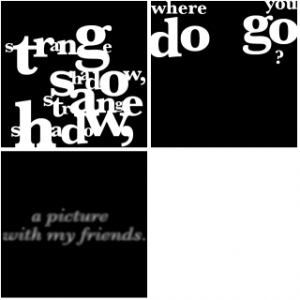Shadows Never Sleep is a set of new pieces from Aya Karpinska, created as part of her master’s thesis at Brown. The culmination and centerpiece of the project is the (eponymous) Shadows Never Sleep which, along with From the Balcony, comprises a solid exploration of narrative forms afforded by the iPhone’s interface.
A bit more analysis behind the cut.
Shadows Never Sleep (the iPhone piece) reminds me of Jim Rosenberg’s Intergrams and the Stir Fry Texts curated and created by Jim Andrews. How, exactly? They’re all (at some level) works about interface.
The works from Andrews and Rosenberg are textual systems controlled with mouse gestures—for Andrews, more specifically, the gesture of mousing over (with all thematic attachments to web technology intact). A lot of the interest in these pieces, I think, comes from figuring out how the mundane (but still technology-specific!) gesture of moving a mouse can “compose” a text.
Shadows Never Sleep is, likewise, an interface-specific text, though its interface is not the mouse, but the iPhone’s “zoom” gesture.
Zooming has different semantic and functional affordances than mousing over, and I’m wondering how directly that difference can be seen in the structures and narratives of the resulting texts. Andrews and Rosenberg use the mouse as a way to reveal text, change it, or destroy it. The zoom gesture in Shadows Never Sleep, on the other hand, suggests a kind of idempotent fractal self-similarity. Find a part of the text that you like, then zoom in for more detail; zoom out again if you don’t like what you found, and try something else. Zooming suggests both a hierarchy (near, nearer, nearest) and a spatial field, which I think makes it a very satisfying interface choice for interactive narrative.
Reply
You must be logged in to post a comment.

1 comment
Comments feed for this article
Trackback link: http://www.decontextualize.com/2008/08/shadows-never-sleep-by-aya-karpinska/trackback/